 Today is World Press Freedom Day. When I do cartoons about the media I tend to concentrate on the American one and it’s usually to criticize (see previous post). However, there are many journalists throughout the world who are willing to put their lives in danger on a regular basis because they believe in what they do. A free press is indispensable for a free society; it must be protected.
Today is World Press Freedom Day. When I do cartoons about the media I tend to concentrate on the American one and it’s usually to criticize (see previous post). However, there are many journalists throughout the world who are willing to put their lives in danger on a regular basis because they believe in what they do. A free press is indispensable for a free society; it must be protected.
Category: society
LA Clippers owner Donald Sterling
The owner of the LA Clippers is banned for life from the NBA and fined $2.6 million after audiotape of several racist comments he made during a conversation with his girlfriend is released.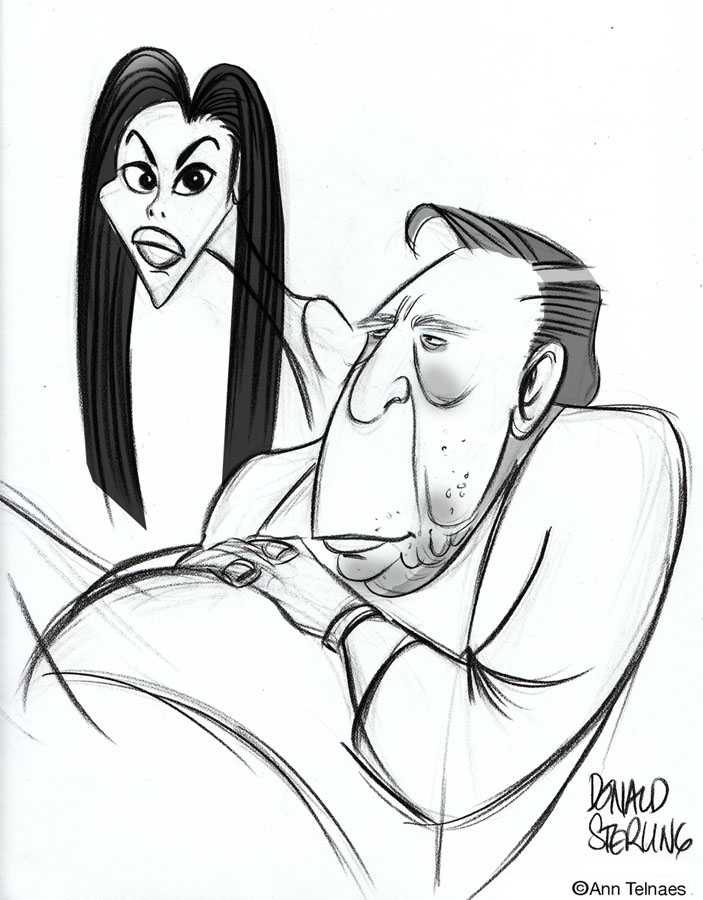 From the looks of this guy he must be an exceptional speaker since his First Amendment right of $peech attracts such young and beautiful women.
From the looks of this guy he must be an exceptional speaker since his First Amendment right of $peech attracts such young and beautiful women.
Guns, guns, guns in Georgia
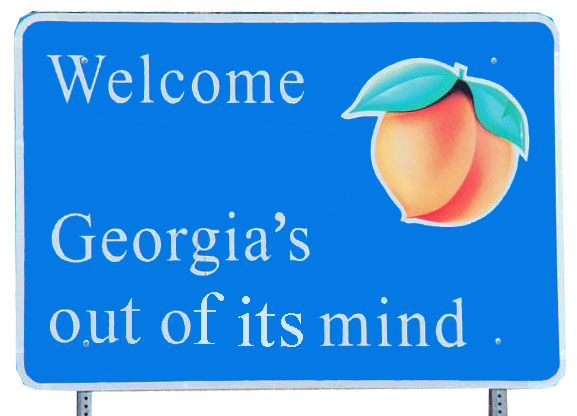 Georgia governor Nathan Deal signed legislation yesterday to allow guns to be carried in government buildings, churches, schools, and bars.
Georgia governor Nathan Deal signed legislation yesterday to allow guns to be carried in government buildings, churches, schools, and bars.
Russian cartoonist Victor Bogorad
While I was at the conference in Caen I met the Russian cartoonist Victor Bogorad. Although I speak no Russian and Victor no English, we did discover that both of us had a limited ability to speak in German so we were able to communicate a little. One of the best things about being among cartoonists though, is that we really don’t need words. Someone will inevitably pick up a pen and start to draw- as Victor did continuously. I was lucky enough to be the recipient of several of Victor’s charming wordless sketches:
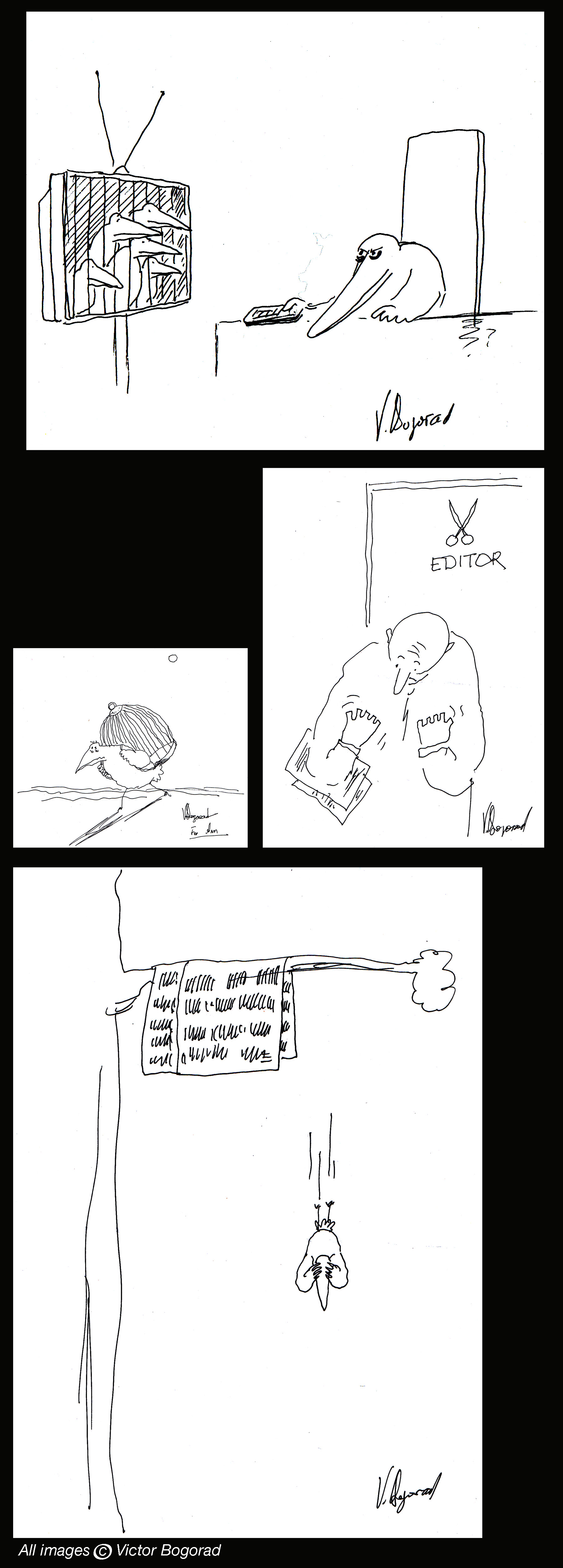
Day 3- Memorial de Caen cartoon conference
Panel: “Cartooning in war time”
Cartoonists from Palestine, Iran, Algeria, Morocco, and Russia discuss working in countries under repressive governments and during wartime.
 Mohammad Sabaaneh, Palestine
Mohammad Sabaaneh, Palestine
“The most hard thing a cartoonist faces in the Arab world… is the audience”
 Javad Alizadeh, Iran
Javad Alizadeh, Iran
“If I think about danger, I would never draw a cartoon”
 Victor Bogorad, Russia
Victor Bogorad, Russia
“Most magazines and newspapers prefer not to deal with the subject” (Putin and Ukraine)
 Khalid Gueddar, Morocco
Khalid Gueddar, Morocco
“Sex, Religion, Royal family” (taboos in Morocco)
 Djamel Lounis, Algeria
Djamel Lounis, Algeria
“No satirical reviews in Algeria anymore (due to) repressive laws concerning journalists”
No cameras in the Supreme Court
The Supreme Court heard oral arguments this past Tuesday for Sebelius v Hobby Lobby, one of the cases which brings up the question whether a business can deny its female employees birth control coverage under Obamacare because of the owners’ religious beliefs. As usual, the line for public seating started early. This is the scene Saturday morning:
By Tuesday the line had grown to this:
Only about 100 members of the public are seated for SCOTUS arguments; about another 100 seats are for the press and select choice seats are designated for guests of the Justices. Cameras are not allowed in the courtroom so the majority of Americans never get the opportunity to watch as one of their three branches of government makes important decisions which affect their civil liberties and personal lives.
My take about cameras in the courtroom from the Washington Post’s Post Partisan blog yesterday.
Here’s a good piece by Washington Post blogger Alyssa Rosenberg on the subject of cartoonists being allowed in the court.
Pat Oliphant, the best of the best
Just returned from a quick trip to NYC to attend a gallery opening of the great cartoonist Pat Oliphant. Here’s a few photos: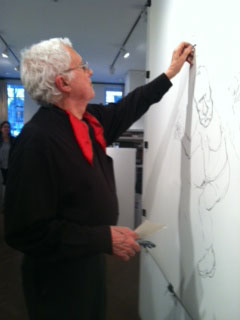
Oliphant drawing

Ed Sorel & Jeff Danziger
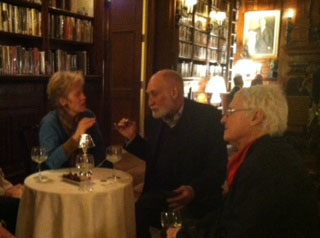
Signe Wilkinson, Tony Auth, Pat Oliphant at reception
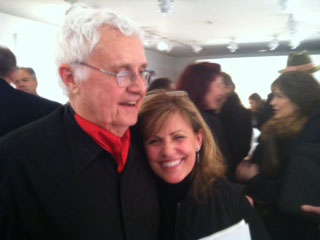
Pat likes to play the crabby cartoonist but he’s really a sweetie
24 hour speculation on Malaysia flight 370 disappearance
The cable news channels is having a field day with the disappearance of Malaysia Air flight 370, now in its ninth day. Especially CNN, as Eric Wemple tweeted: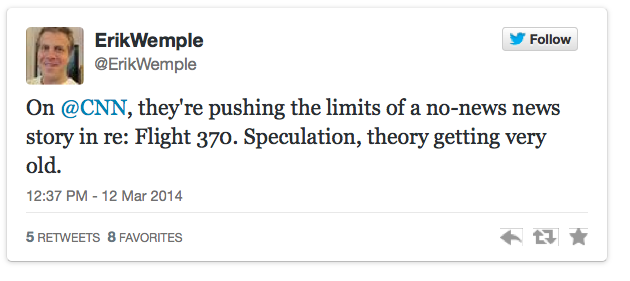
We’re having some video problems so my latest animation which deals with this subject isn’t posted yet (hopefully sometime this morning) but meanwhile here’s an archived cartoon from 2005: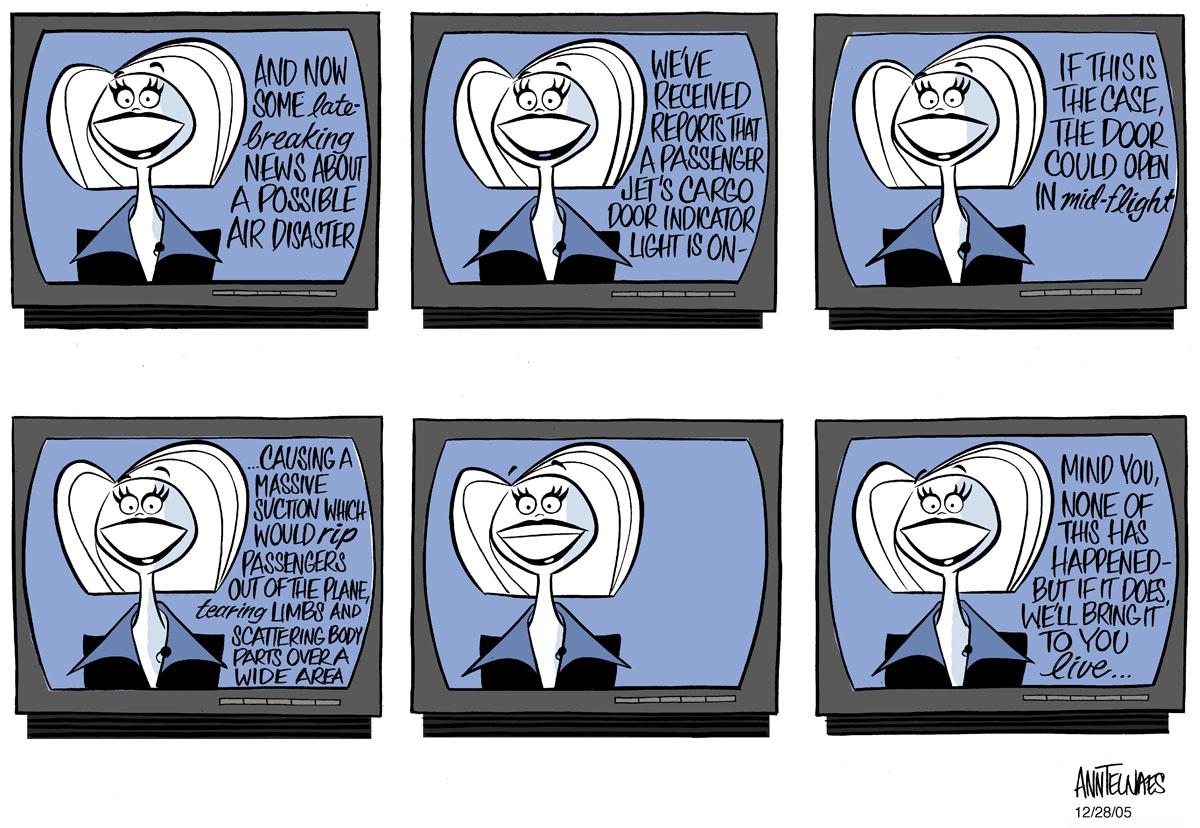 If I recall correctly, the Denver-bound Frontier was diverted back to Los Angeles after the plane’s cargo door warning light had turned on- which left plenty of time for CNN to speculate about what exactly would happened if the door ripped off, all while the flight was still in the air and passengers were being readied for an emergency landing. Thankfully the plane landed safely and we were all spared watching CNN do wall to wall coverage of the carnage on the tarmac.
If I recall correctly, the Denver-bound Frontier was diverted back to Los Angeles after the plane’s cargo door warning light had turned on- which left plenty of time for CNN to speculate about what exactly would happened if the door ripped off, all while the flight was still in the air and passengers were being readied for an emergency landing. Thankfully the plane landed safely and we were all spared watching CNN do wall to wall coverage of the carnage on the tarmac.
The Five Questions
I follow British editorial cartoonists and cartooning organizations on twitter so this morning there were several posts about the death of Tony Benn, a revered figure in UK politics. I have to admit I wasn’t aware of the impact he had on British politics. Listen to what he says about democracy and money in politics- and take a look at his ‘Five questions of Power’: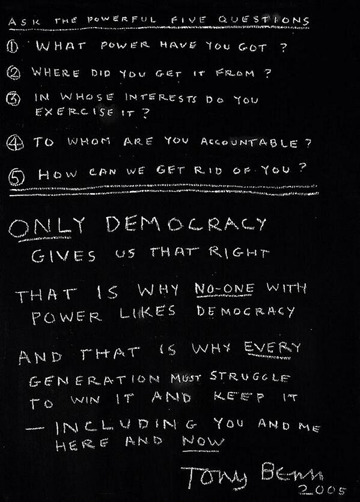 I’m afraid I have to agree with Benn that “It’s questionable whether either in America or Britain we have a democracy” when money is considered speech by the Supreme Court. See questions 2, 3, 4.
I’m afraid I have to agree with Benn that “It’s questionable whether either in America or Britain we have a democracy” when money is considered speech by the Supreme Court. See questions 2, 3, 4.
Anti-gay discrimination in the name of religion
I cannot tell you how furious I get when hearing a politician or representative from a special interest group trying to justify these so-called “Religious Freedom” bills now making their way through several state legislatures. These bills would allow businesses to deny services to gays because of the employer’s religious beliefs- which isn’t any different from not allowing blacks to sit at lunch counters reserved for white customers.

My take at the Washington Post
UPDATE: Arizona Governor Jan Brewer vetoes bill
RELATED: Oklahoma judge rules Texas’ gay marriage ban unconstitutional; cites “state-imposed inequality”
Sochi sketch
I haven’t watched the Olympics for years (not a fan of the media turning every US athlete’s life into a production number) but I did watch some of the ice dancing this year. I especially enjoyed watching Meryl Davis and Charlie White’s performances, not just for their abilities but for the caricature potential. I couldn’t resist Davis’ perfect porcelain doll features and White’s crazy hair.
CalArts, A113, and Bill Moore
The March issue of Vanity Fair has an article about the the early character animation program at California Institute of the Arts, better known as CalArts. It focuses mainly on the students who attended when the program first started in 1975 and a few years afterwards. Even if you’re not in the animation business you’ll recognize some of these names: Tim Burton, John Lasseter, Brad Bird, Glen Keane, Nancy Beiman, Jerry Rees, Mike Giaimo, John Musker, to name a few. It really is amazing all that talent came from a small art school within the span of a few years.
The article gives the reader some behind-the-scenes glimpses into life as a character animation student at CalArts; the life drawing classes (which for many students was their first introduction to nude models), the infamous Halloween parties, the meaning behind the room A113, and the profound impact one of the teachers had on so many of the students.
That teacher was Bill Moore. Formerly from the famous Chouinard Art Institute, he taught color and design and was the one who influenced so many of the students in the character animation program. I attended CalArts in the early 80’s and had Moore as my teacher during my first year, the last class he taught before becoming ill. As the article mentions, he was quite a character and very intimidating. I remember agonizing over projects and the fear which would fill the classroom when he walked in to review our efforts, hung on the wall for review. We all had heard the legend of Bill Moore (who always had a lit cigarette in his hand) setting on fire any work he didn’t like. But he was a wonderful teacher. I learned everything I know about design from Bill Moore. And even though he sometimes came across as too tough, too insensitive- I still have a vivid memory of him briefly letting his cranky persona down.
At the end of particularly stressful design class my classmates and I retreated to our animation desks to resume work on our pencil tests and lick our wounds. My friend and cubicle mate, Lynette was especially irritated with Moore that day and decided to challenge him as he walked looking around as he did occasionally after class. Why do you act that way when you teach, she asked him. Do you have to be so rude? I expected him to reply with his usual one-liners but instead his expression softened and said “because when you get out there it’ll be much worse”.
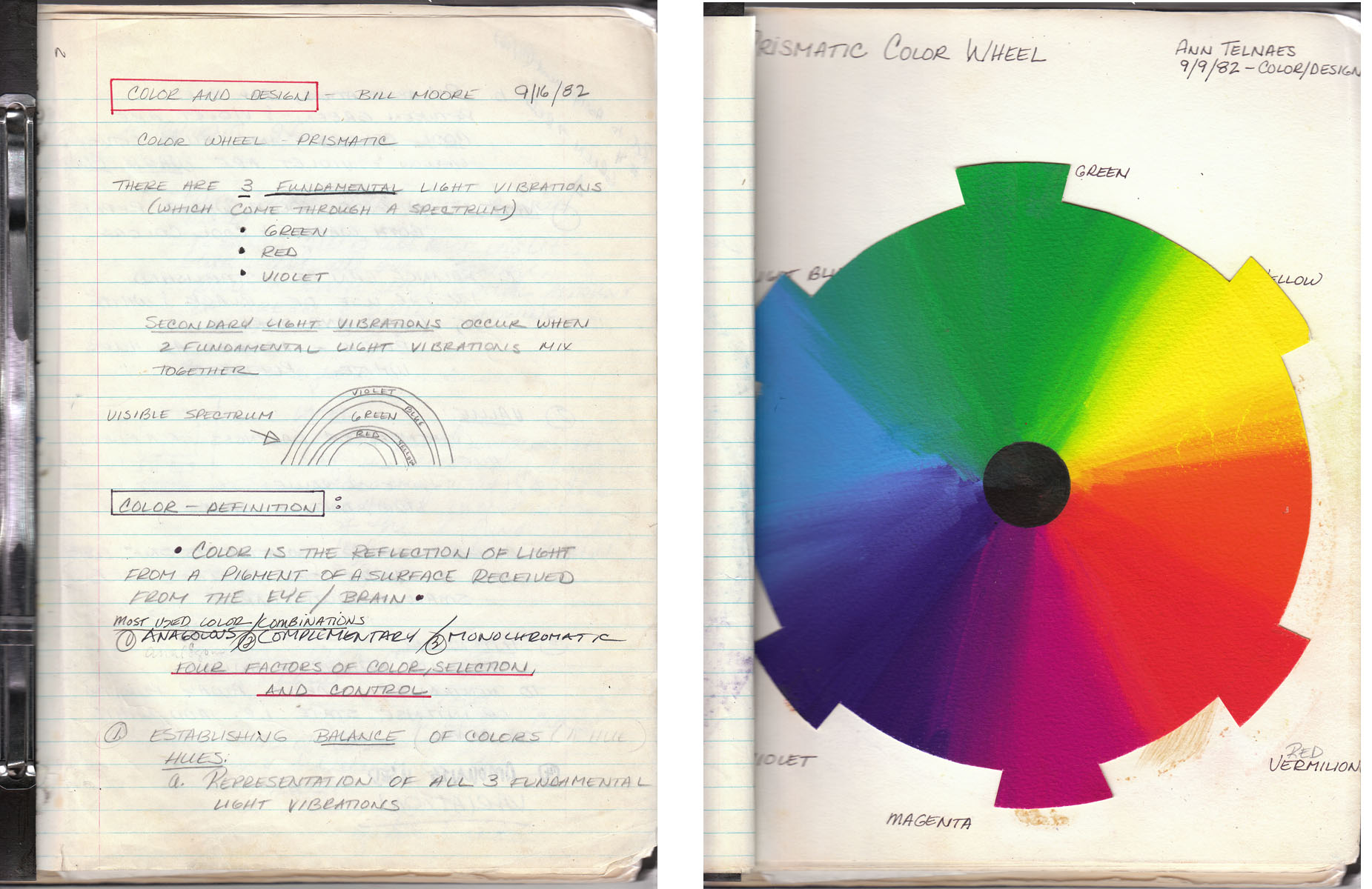 Notes from my first day in Bill Moore’s class
Notes from my first day in Bill Moore’s class
 A design assignment for Bill Moore’s class- 1983 (I recall him not being particularly impressed)
A design assignment for Bill Moore’s class- 1983 (I recall him not being particularly impressed)
